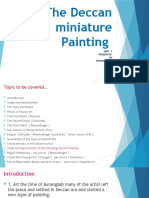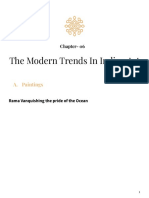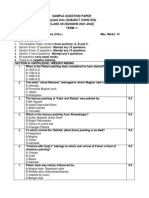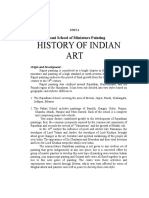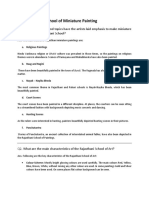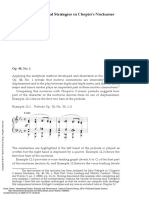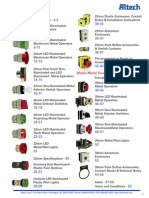Professional Documents
Culture Documents
Full Notes Rajasthani School Class 12
Full Notes Rajasthani School Class 12
Uploaded by
rudrapratap15487Original Description:
Copyright
Available Formats
Share this document
Did you find this document useful?
Is this content inappropriate?
Report this DocumentCopyright:
Available Formats
Full Notes Rajasthani School Class 12
Full Notes Rajasthani School Class 12
Uploaded by
rudrapratap15487Copyright:
Available Formats
CLASS 12 : FINE ARTS
UNIT : 1 - RAJASTHANI SCHOOL OF MINIATURE PAINTING
ORIGIN AND DEVELOPMENT
Rajasthani school originated in Rajasthan and parts of Madhya Pradesh in the present
time, such as Mewar, Bundi, Kota, Jaipur, Bikaner, Kishangarh, Jodhpur (Marwar),
Malwa, Sirohi between the 16th and early 19th centuries.
Scholar Anand Coomaraswamy in 1916 coined the term ‘Rajput Paintings’.
Paintings were painted on waslis—layered, thin sheets of handmade papers glued
together to get the desired thickness.
Camel and squirrel hair were used in brushes.
By the impact of Apabhransha style Rajasthani school came into being and was called as
Rajasthani, Rajput or Hindu school of painting.
In the beginning the paintings of this school remain confined to different kings for their
amusement. The artist initially prepared the precious paintings for royal court but
gradually paintings reach the common folk.
THEMES
By the sixteenth century, Vaishvanism in the cults of Rama and Krishna had become
popular in many parts of western, northern and central India as part of the Bhakti
movement.
The 12th century by Jayadeva, who is believed to have been the court poet of Lakshmana
Sen of Bengal, Gita Govinda, the ‘Song of the Cowherd’, is a lyrical poem in Sanskrit,
evoking shringara rasa, portraying the mystical love between Radha and Krishna through
worldly imageries.
Bhanu Datta, a Maithil Brahmin who lived in Bihar in the fourteenth century, composed
another favourite text of artists, Rasamanjari, interpreted as the ‘Bouquet of Delight’.
Rasikapriya, by Keshav Das translated as ‘The Connoisseur’s Delight’, is replete with
complex poetic interpretations and was composed to incite aesthetic pleasure to elite
courtiers.
YOUTUBE :- Study Box By Sagarika
INSTAGRAM :- sagarika.singh_
TELEGRAM :- Studyboxbysagarika
Kavipriya, another poetic work by Keshav Das, It is a tale of love and its tenth
chapter evocatively titled BARAMASA engages with the most enduring climactic
description of the 12 months of the year.
Bihari Satsai, authored by Bihari Lal, constituting 700 verses (satsai), is composed in
the form of aphorisms and moralising witticism. The Satsai has been largely painted at
Mewar.
Texts, such as the RAMAYANA, BHAGVATA PURANA, MAHABHARATA, DEVI
MAHATMYA and the like were favourites with all schools of painting.
A large number of paintings record darbar scenes and historic moments; depict hunting
expeditions, wars and victories; picnics, garden parties, dance and music performances;
rituals, festivals and wedding processions; portraits of kings, courtiers and their families;
city views; birds and animals.
SUB-SCHOOLS OF RAJASTHANI MINIATURE
MEWAR SCHOOL
The Mewar School is widely associated with an early dated set of Ragamala paintings
painted at Chawand in 1605 by an artist named Nisardin.
The reign of Jagat Singh I (1628–1652) is recognised as the period when pictorial
aesthetics got reformulated under virtuoso artists Sahibdin and Manohar, who added
new vitality to the style and vocabulary of Mewar paintings.
Sahibdin painted the Ragamala (1628), Rasikapriya, Bhagvata Purana (1648) and the
Yuddha Kanda of Ramayana (1652), a folio of which is discussed here.
Manohar’s most significant work is that of Bal Kanda of Ramayana (1649). Another
exceptionally gifted artist, Jagannath, painted the Bihari Satsai in 1719, which remains
a unique contribution of the Mewar School.
Other texts like Harivamsha and Sursagar were also illustrated in the last quarter of the
seventeenth century.
Mewar painting in the eighteenth century increasingly became secular and courtly in
ambience.
RAJASTHAN WAS AFFECTED BY THE MUGHALS BUT MEWAR DID NOT COME
UNDER THEIR CONTROL UP TO THE LAST.
This was the reason the Rajasthani school developed in PUREST FORM IN MEWAR.
YOUTUBE :- Study Box By Sagarika
INSTAGRAM :- sagarika.singh_
TELEGRAM :- Studyboxbysagarika
BUNDI SCHOOL
IN THE 17TH CENTURY, BUNDI IS REMARKABLE FOR ITS UNBLEMISHED COLOUR
SENSE AND EXCELLENT FORMAL DESIGN.
Bundi Ragamala dated 1591, assigned to the earliest and formative phase of Bundi
painting, has been painted at Chunar in the reign of Bhoj Singh.
The Bundi school blossomed under the patronage of two rulers—Rao Chattar Sal, and
his son Rao Bhao Singh .
Bundi paintings during the 18th century appear to have imbibed Deccani aesthetics, such
as love for bright and vivid colours.
Last stages of painting at Bundi are best exemplified by several wall paintings in the
palace.
A distinct feature of Bundi and Kota School is a keen interest in the depiction of lush
vegetation; picturesque landscape with varied flora, wildlife and birds; hills and thick
jungles; and water bodies.
It also has a series of fine equestrian portraits.
JODHPUR SCHOOL
In Jodhpur school the presence of Mughals since the 16 th century, influence of their
visual aesthetics.
One of the earliest sets painted in Pali is a Ragamala set by artist Virji in 1623.
A productive period of painting was ushered in by Maharaja Jaswant Singh (1638–1678)
in the mid–seventeenth century.
The last phase innovative of Jodhpur painting coincided with the reign of Man Singh
(1803–1843) where significant sets painted during his time are the RAMAYANA (1804),
DHOLA-MARU, PANCHATANTRA (1804) AND SHIVA PURANA.
BIKANER SCHOOL
Rao Bika Rathore established one of the most prominent kingdoms of Rajasthan,
Bikaner, in 1488.
In the reign of Anup Singh, Ruknuddin was the master artist, painted significant texts,
such as the RAMAYANA, RASIKAPRIYA AND DURGA SATPSATI.
Ibrahim, Nathu, Sahibdin and Isa were other well-known painters in his atelier.
A PREVAILING PRACTICE IN BIKANER WAS TO SET UP STUDIOS CALLED MANDI,
WHERE A GROUP OF ARTISTS WORKED UNDER THE SUPERVISION OF A MASTER
YOUTUBE :- Study Box By Sagarika
INSTAGRAM :- sagarika.singh_
TELEGRAM :- Studyboxbysagarika
ARTIST - RUKNUDDIN, IBRAHIM AND NATHU MANAGED SOME OF THESE
PROFESSIONAL STUDIOS.
Portraits of artists is unique to the Bikaner School and most of them are inscribed with
information regarding their ancestry they are referred to as Ustas or Ustad.
Ibrahim’s studio appears to be most prolific as his name occurs on different sets of
Baramasa, Ragamala and Rasikapriya.
Royal archival day-to-day diaries, and numerous inscriptions on Bikaner paintings make
it one of the best documented schools of painting.
KISHANGARH SCHOOL
Widely held among the most stylised of all Rajasthani miniatures, Kishangarh paintings
are DISTINGUISHED BY THEIR EXQUISITE SOPHISTICATION AND DISTINCT FACIAL
TYPE EXEMPLIFIED by arched eyebrows, lotus petal shaped eyes slightly tinged with
pink, having drooping eyelids, a sharp slender nose and thin lips.
Mid–seventeenth century under the patronage of Man Singh artists were already working
in the Kishangarh court.
KRISHNA LILA THEMES became personal favourites for the rulers of Kishangarh.
Sawant Singh’s most celebrated and outstanding artist was Nihal Chand and composed
paintings on Sawant Singh’s poetry that portrayed the theme of divine lovers—Radha and
Krishna.
JAIPUR SCHOOL
The Jaipur School of painting originated in its former capital Amer.
Mughal influence was clearly visible in Jaipur school.
Under Sawai Jai Singh, Jaipur School of paintings thrived under his reign and emerged
as a well-defined independent school - also invited eminent craftsmen and other artists to
settle down in Jaipur and reorganised the Suratkhana (the place where paintings were
made and stored).
Artists during his reign painted sets based on RASIKAPRIYA, GITA GOVINDA,
BARAMASA AND RAGAMALA, where the hero’s figure is in striking resemblance with
the king.
Famous painter, of his atelier was Sahibram and Muhammad Shah .
IN 18TH CENTURY, UNDER THE ASPIRATION OF SAWAI PRATAP SINGH (1779–1803)
REFORMULATED WITH THE BLEND OF MUGHAL AND INDIGENOUS STYLISTIC
FEATURES - SPLENDOUR, LITERARY AND RELIGIOUS THEMES, SUCH AS GITA
GOVINDA, RAGAMALA, BHAGVATA PURANA, ETC., GOT RENEWED STIMULUS.
YOUTUBE :- Study Box By Sagarika
INSTAGRAM :- sagarika.singh_
TELEGRAM :- Studyboxbysagarika
By the early 19th century, there was A LAVISH USE OF GOLD.
Jaipur preferred large size formats and produced life-size portraits.
SUBJECT MATTER
Both religious and romantic themes are painted beautifully in miniature paintings of
Rajasthan.
As a religious subject matter artist chosen the episode from Bhagwat Puran, Ramayan,
Geet-Govind, Sur-Sagar etc.
And as romantic themes artist illustrated Ragamala paintings, Rasik Priya,
Ramchandrika and Nayak-Nayika bhed.
Barah-masa is also painted beautifully in Rajasthani miniature painting.
RADHA AND KRISHNA IS BEAUTIFULLY PAINTED IN BOTH RELIGIOUS AND
ROMANTIC THEMES.
The painters was also beautifully depicted court scene, battle scene, hunting scene and
royal portraits.
MAIN FEATURES OF RAJASTHANI SCHOOL OF MINIATURE PAINTINGS
1. In Rajasthani miniature painting artist use bright and brilliant colours such as red,
orange, bright green and blue
2. Male and female figures have long nose, oval shaped face, elongated fish like eyes and the
female figures painted slim flexible and tall like creeper.
The male figure used to wear loose fitting garments, pataka and turban on their
head.
Female figure used to wear loose skirt, choli and transparent chunri.
3. In rajasthani paintings birds and animals have been drawn in decorative style where is
elephant, horse are drawn naturally under the influence of Mughals.
4. Trees are ornamental, flowers have been drawn in bunches.
5. Hills and mountains have been depicted in Persian style.
6. Figures have been drawn in group in a dramatic fusion.
7. To show night scene only the colour of sky has been changed. Moon and stars have
been painted on them and other things are as usual like day scene.
8. RAGA-MALA PAINTINGS ARE DISTINCT FEATURES OF RAJPUT MINIATURE PAINTING,
WHICH ARE PAINTED ENORMOUSLY. RAGA-MALA PAINTINGS ARE PICTORIAL
REPRESENTATION OF INDIAN RAGA AND RAGINI.
YOUTUBE :- Study Box By Sagarika
INSTAGRAM :- sagarika.singh_
TELEGRAM :- Studyboxbysagarika
9. The total space in the painting has been divided by the use of different colours in
different shapes.
10. Use of decorative, minute and rhythmic outline is an important feature of Rajasthani
miniature painting.
PAINTINGS IN RAJASTHANI SCHOOL OF MINIATURE PAINTING
(VERY IMPORTANT TABLE**)
YOUTUBE :- Study Box By Sagarika
INSTAGRAM :- sagarika.singh_
TELEGRAM :- Studyboxbysagarika
MARU RAGINI
Artist- Sahibdin
School - Rajasthani school
Sub- school- Mewar
Medium- Water colour on paper
Technique- Tempera
Subject Matter- Maru Ragini from Mewar is one of
the important painting in Ragamala paintings series.
Maru Ragini, classifies Maru as the ragini of Raga
Shri and describes her physical beauty and its effect
on her beloved.
Description-
Maru Ragini is a painting from the series of Ragamala paintings made by Sahibdin the court
painter of Mewar. In this painting the king with his queen is riding a camel in a yellow
desert background. Both the king and queen are wearing highly ornamental dress and
jewelleries.
Background is painted in light washes of green colour. The camel is leading by an attendant
who carries a stick on his hand. Two escorts are moving on the foreground, who are carrying
sticks in their hands, swords and daggers in their sashes. A hunting dog is running ahead of
two escorts. The sky is deep blue. The dresses of all the figures painted in a manner so that
it looks transparent. Some inscriptions are written in Devnagari characters on the top of the
painting.
Collection- National museum New Delhi
CHAUGHAN PLAYER
Artist- Dana
School- Rajasthani school
Sub school- Jodhpur
YOUTUBE :- Study Box By Sagarika
INSTAGRAM :- sagarika.singh_
TELEGRAM :- Studyboxbysagarika
Medium- Watercolour on paper
Technique- Tempera
Subject Matter- This painting,
depicting a princess playing Polo
(Chaugan) with companions, by artist
Dana represents Jodhpur painting of
Man Singh’s reign.
Description-
The painting is inscribed with a line
on the upper portion that is
translated as, “beautiful maidens on horsebacks, playing”.
The two horses in the upper section of the painting are galloping towards each other, while
the horses in the lower section are moving in the opposite direction. They all are dressed in
Rajput costume. The group is trying to tackle a ball with their long polo stick.
The horses are painted in different colours. The ladies have rounded forehead, their eyes are
elongated and their skirts are spreads out like bell with the movement of their action. A little
foliage in the foreground is rendered in stylized manner against a flat green background. The
painting is full of dynamic movement.
Collection- National Museum, New Delhi
KRISHNA ON SWING
Artist- Nuruddin
School- Rajasthani school
Sub school- Bikaner
Medium- Watercolor on paper
Technique-Tempera
Subject Matter- This painting, is an illustration of Rasikapriya which presents a stark and
simple composition with minimal and suggestive representation of architecture and
elements of landscape.
YOUTUBE :- Study Box By Sagarika
INSTAGRAM :- sagarika.singh_
TELEGRAM :- Studyboxbysagarika
Description-
An architectural pavilion in the upper part of the painting pictorially qualifies that space as
the ‘palatial interior’, while few trees on the green
grassland suggest ‘outdoors and pastoral’
landscape. The cult of Radha and Krishna was
very popular in the kingdoms of Rajasthan.
In this vertical composition Krishna is shown on
a swing at the top left side of the painting and in
the top right side a royal female figure (Gopi) is
sitting on a carpet. Both the figures are composed
in royal palace.
In the lower section of the painting, Krishna is
sitting in the left side of a garden and in the right
side a female figure is drawn beautifully. In
between both of the figure another female figure
in standing and approaching Krishna in a lyrical
manner.
Krishna is coloured with blue and all female figures are light yellow. All the figures are
dressed in Rajput costume. Background of this painting is light blue and foreground is light
washes of green.
Collection- National Museum, New Delhi
RADHA BANI THANI
Artist- Nihalchand
School- Rajasthani school
Sub school- Kishangarh
Medium- Watercolour on paper
Technique- Tempera
YOUTUBE :- Study Box By Sagarika
INSTAGRAM :- sagarika.singh_
TELEGRAM :- Studyboxbysagarika
Subject Matter- Bani Thani was Raja Sawant Singh’s muse for the poetry he wrote,
celebrating the love of Radha and Krishna. He writes about her in a poem Bihari Jas
Chandrika, which became the basis for Nihal chand’s painting of Bani Thani, thus,
representing a blending of poetry and painting. Sawant Singh is said to have been
passionately in love with a young singer, who was accorded the title ‘Bani Thani’, the
bewitching lady of fashion, because of her unparalleled beauty and elegance.
Description-
This is one of the well known painting of Rajasthani miniature from a small state of
Kishangarh. The exaggerated facial type of Kishangarh, which becomes the distinctive and
salient stylistic feature of the Kishangarh School,
is believed to have been derived from the
attractively sharp facial features of Bani Thani.
This painting of Bani-Thani is a highly stylized
portrait of Radha made during the kingship of
Raja Sawant Singh.
Face of Radha is elongated; she has pointed nose
and chin, arched shaped eyebrows and thin red
lips. Her black curly hair hanging down to the
waist and her long tempering finger of left hand is
holding two lotus bud. With her right hand she is
holding the edges of her chunri which is
decorated with golden motifs. Dress and
jewelleries are reflects the fashion of
contemporary Rajput royalty. The background is painted in deep blue. The effect of
transparent chunri is painted wonderfully.
Collection-National Museum, New Delhi
YOUTUBE :- Study Box By Sagarika
INSTAGRAM :- sagarika.singh_
TELEGRAM :- Studyboxbysagarika
BHARAT MEETS RAMA AT CHITRAKUT
Artist- Guman
School- Rajasthani School
Sub school- Jaipur
Medium- Watercolour on paper
Technique- Tempera
Subject Matter- Bharat was away when
Rama was sent to exile. After the passing
away of Dashratha, overcome with grief
and filled with remorse, Bharat along
with the three mothers, sage Vasishtha
and courtiers visits Rama to persuade
him to return to Ayodhya.
Description-
This painting of Ramayana by Guman, made between 1740 and 1750, is a classic example
of a continuous narrative. This painting is depicts a scene from Ramayan, when Bharat
come to Chitrakut to meet Rama with his three mothers. (After the passing away of
Dashratha, overcome with grief and filled with remorse, Bharat along with the three
mothers, sage Vasishtha and courtiers visits Rama to persuade him to return to Ayodhya).
Artist Guman begins the narrative from the left and ends it on the right. There are all
together forty-nine figures are composed in different groups in this painting.
A scene is reflecting the episode of Bharat to take back Rama to Ayodhya from Chitrakut. In
the right lower corner Rama listening to Vashishtha about his father's death. Another
composition in middle Rama meets his mothers accompanied by Lakshman and Sita. In
another composition Rama meets to his three mothers.
All female figures are in white saris except Sita. She is wearing a red sari. Jungle scene is
depicting behind of this composition. A prospectively drawn house is depicting in the
background. The use of different shades of green colour is speciality of this painting.
Collection- National Museum, New Delhi
YOUTUBE :- Study Box By Sagarika
INSTAGRAM :- sagarika.singh_
TELEGRAM :- Studyboxbysagarika
You might also like
- Genealogy of RevolutionDocument5 pagesGenealogy of RevolutionAli BalloutNo ratings yet
- Final NotesDocument53 pagesFinal NotesChandy Alex Koshy94% (72)
- The Ultimate Guide To Starting An Artist Management CompanyDocument25 pagesThe Ultimate Guide To Starting An Artist Management CompanyRosa Melcacho0% (1)
- 6 Limbs of Indian Art: ShadangaDocument10 pages6 Limbs of Indian Art: ShadangaShivam Aggarwal100% (1)
- Six Limbs of Indian PaintingDocument9 pagesSix Limbs of Indian PaintingAnupama Rawat78% (9)
- Xii Painting Objective QuestionDocument6 pagesXii Painting Objective QuestionHitesh RuhalNo ratings yet
- 12th Mughal Miniature Paintng-1Document32 pages12th Mughal Miniature Paintng-1sandy Boi100% (4)
- Objective Type Question Class - Xiith Term Test - 1Document67 pagesObjective Type Question Class - Xiith Term Test - 1sandy Boi100% (5)
- Introduction - Origin and Development - Sub-Schools - Mewar, Bondi, Jodhpur, Bikaner, Kishangarh, Jaipur - PantingsDocument12 pagesIntroduction - Origin and Development - Sub-Schools - Mewar, Bondi, Jodhpur, Bikaner, Kishangarh, Jaipur - PantingsAnupama RawatNo ratings yet
- Class Xii Fine Art's Notes Unit 1 Rajasthani School of Miniature RaingtingDocument14 pagesClass Xii Fine Art's Notes Unit 1 Rajasthani School of Miniature RaingtingPriyanshu Guptq100% (1)
- The Rajasthani School of Miniature PaintingDocument3 pagesThe Rajasthani School of Miniature PaintingSamman Gupta100% (1)
- Full Notes Pahari School Class 12Document6 pagesFull Notes Pahari School Class 12Hitesh Kumar50% (4)
- UNIT-1 History of Indian Art The Rajasthani School of Miniature Painting Origin and DevelopmentDocument10 pagesUNIT-1 History of Indian Art The Rajasthani School of Miniature Painting Origin and DevelopmentWaterNo ratings yet
- Class Xii Fine Art's Notes Unit 1 Rajasthani School of Miniature RaingtingDocument14 pagesClass Xii Fine Art's Notes Unit 1 Rajasthani School of Miniature RaingtingZyRoxNo ratings yet
- 12th Rajasthani Miniature Painting-2Document33 pages12th Rajasthani Miniature Painting-2sandy Boi100% (1)
- 12th Rajasthani Miniature Painting-2Document33 pages12th Rajasthani Miniature Painting-2sandy BoiNo ratings yet
- 12th Rajasthani Miniature PaintingDocument34 pages12th Rajasthani Miniature PaintingHarshita Kaur100% (2)
- Class Xii Fine Arts Rajasthani Miniature Painting Worksheet 2Document2 pagesClass Xii Fine Arts Rajasthani Miniature Painting Worksheet 2Renu Devi100% (1)
- 'FINE ARTS' NOTES & Syllabous PDFDocument29 pages'FINE ARTS' NOTES & Syllabous PDFShrey GoelNo ratings yet
- Bengal School of Painting 12Document11 pagesBengal School of Painting 12Anupama Rawat100% (4)
- Class - 12th Chapter - 03 The Mughal School of Miniature PaintingDocument11 pagesClass - 12th Chapter - 03 The Mughal School of Miniature PaintingNikita Verma100% (2)
- 12th Deccani Miniature PaintingDocument25 pages12th Deccani Miniature Paintingsandy BoiNo ratings yet
- The Mughal School of Miniature Painting: Origin and DevelopmentDocument4 pagesThe Mughal School of Miniature Painting: Origin and Developmentsangarfree100% (7)
- Class - 12th Chapter - 04 Deccan School of Miniature PaintingDocument10 pagesClass - 12th Chapter - 04 Deccan School of Miniature PaintingNikita Verma100% (1)
- Class 12th Chapter No - 06 The Modern Trends in Indian ArtDocument36 pagesClass 12th Chapter No - 06 The Modern Trends in Indian ArtNikita Verma100% (4)
- Deccan School of Miniature Painting XiiDocument10 pagesDeccan School of Miniature Painting XiiAnupama Rawat50% (2)
- Class - 12th Chapter No - 5 The Bengal School of PaintingDocument25 pagesClass - 12th Chapter No - 5 The Bengal School of PaintingNikita Verma100% (1)
- 12th Pahari MiniatureDocument20 pages12th Pahari Miniaturesandy Boi50% (2)
- 12th Pahari MiniatureDocument20 pages12th Pahari Miniaturesandy BoiNo ratings yet
- Class 12, Deccan School of Painting NOTESDocument11 pagesClass 12, Deccan School of Painting NOTESsanika100% (3)
- Class - 12th Chapter - 01 The Rajasthani School of Miniature PaintingDocument11 pagesClass - 12th Chapter - 01 The Rajasthani School of Miniature PaintingNikita Verma100% (4)
- Sculptures of Modern Trends in Indian ArtDocument7 pagesSculptures of Modern Trends in Indian ArtAnupama Rawat100% (2)
- Ch.6. Q. & Ans. of Introduction To The Bengal School of PaintingDocument10 pagesCh.6. Q. & Ans. of Introduction To The Bengal School of PaintingSamman GuptaNo ratings yet
- PDF 12th NotesDocument31 pagesPDF 12th NotesXndrcage Bravestone100% (2)
- Painting & GraphicsDocument4 pagesPainting & GraphicsSrijani MondalNo ratings yet
- Class - 12th Chapter - 02 Pahari School of Miniature PaintingDocument9 pagesClass - 12th Chapter - 02 Pahari School of Miniature PaintingNikita Verma100% (1)
- Mughal School of Miniature Paintings: 16 Century A.D. To 19 Century A.DDocument17 pagesMughal School of Miniature Paintings: 16 Century A.D. To 19 Century A.DAnshika Goel50% (2)
- MCQ and Important Notes (Bengal and Modern School of Art)Document65 pagesMCQ and Important Notes (Bengal and Modern School of Art)Parth Saxena100% (1)
- Sample Question Paper Applied Arts (SUBJECT CODE-052) CLASS XII (SESSION 2021-2022) Term - 1Document4 pagesSample Question Paper Applied Arts (SUBJECT CODE-052) CLASS XII (SESSION 2021-2022) Term - 1Aaløk ßhaskarNo ratings yet
- 12 Painting-Chapter-The Bengal School of Painting-NotesDocument9 pages12 Painting-Chapter-The Bengal School of Painting-NotesPrataya Das47% (19)
- The Asian School, Dehradun Multiple Choice Questions 2019: Painting Class - Xii Chapter-12Document2 pagesThe Asian School, Dehradun Multiple Choice Questions 2019: Painting Class - Xii Chapter-12Gaurav KumarNo ratings yet
- Full Notes Deccan School Class 12Document5 pagesFull Notes Deccan School Class 12Hitesh KumarNo ratings yet
- History of Indian ArtDocument3 pagesHistory of Indian ArtShashi Kumar0% (1)
- New Painting Cbse Class 12 of Fine ArtsDocument12 pagesNew Painting Cbse Class 12 of Fine ArtsRupesh50% (4)
- MCQ Class Xii PaintingDocument5 pagesMCQ Class Xii PaintingAyshu92% (13)
- Chand Bibi Playing PoloDocument4 pagesChand Bibi Playing Polovivek33% (3)
- Ch.03. Q. The Mughal School of Miniature PaintingsDocument2 pagesCh.03. Q. The Mughal School of Miniature PaintingsSamman Gupta0% (1)
- The Deccan School of Miniature PaintingDocument4 pagesThe Deccan School of Miniature PaintingSamman GuptaNo ratings yet
- 12th Mughal Miniature PaintngDocument34 pages12th Mughal Miniature PaintngHarshita Kaur100% (2)
- Painting Practical Viva PDFDocument3 pagesPainting Practical Viva PDFUmang Raj33% (3)
- Unit 1 - Rajasthan School of Art PDFDocument4 pagesUnit 1 - Rajasthan School of Art PDFTripti SrivastavNo ratings yet
- Sadanga: The Six Limbs of Indian Art and PaintingsDocument17 pagesSadanga: The Six Limbs of Indian Art and PaintingsAnkita GNo ratings yet
- 'Fine Arts' NotesDocument28 pages'Fine Arts' NotesUtkarsh Verma100% (2)
- A Text Book of Fine ArtsDocument41 pagesA Text Book of Fine Artskushalx1316No ratings yet
- Class - Xii - Painting and Sculpture - Study of Pahari Painting - WS - 5 - 2020Document4 pagesClass - Xii - Painting and Sculpture - Study of Pahari Painting - WS - 5 - 2020Davio Danger100% (1)
- Class 12 Complete Book of Fine Art An Introduction To Indian Art 2 English PDFDocument164 pagesClass 12 Complete Book of Fine Art An Introduction To Indian Art 2 English PDFSTUDY FOR JEENo ratings yet
- 11 Painting - Six Limbs of Art - Notes and Video LinkDocument2 pages11 Painting - Six Limbs of Art - Notes and Video LinkKamal Jajoriya100% (1)
- Six Limbs ArtDocument10 pagesSix Limbs ArtSunil Tandan100% (3)
- English Revision Notes XIIDocument41 pagesEnglish Revision Notes XIIRämíz MêmóñNo ratings yet
- (06 Oct, 2023) - 2Document7 pages(06 Oct, 2023) - 2Sumit KumarNo ratings yet
- Rajasthan MiniatureDocument4 pagesRajasthan Miniaturekshitij_garg_2100% (1)
- Asm1 32274Document14 pagesAsm1 32274Krishanu VansamNo ratings yet
- Advanced Cinematography Kit - Hurlbut Visuals - Part 16Document10 pagesAdvanced Cinematography Kit - Hurlbut Visuals - Part 16Nilson ANo ratings yet
- Reading Visual ArtsDocument2 pagesReading Visual ArtsFilsani Brobo0% (1)
- Periods of European Art MusicDocument6 pagesPeriods of European Art MusicandresgunNo ratings yet
- Interpreting Chopin Analysis and Performance - (12 Shared Compositional Strategies in Chopin's Nocturnes Op. 48)Document34 pagesInterpreting Chopin Analysis and Performance - (12 Shared Compositional Strategies in Chopin's Nocturnes Op. 48)Jaime Puig GuisadoNo ratings yet
- Beatus de LiebanaDocument42 pagesBeatus de LiebanaCornel-Georgian DinicăNo ratings yet
- YOU AGAIN by Tyler RobinsonDocument25 pagesYOU AGAIN by Tyler RobinsonAverey LaneNo ratings yet
- ForRTP011321 LAS Arts 7 Q2Melc9 CadizDocument13 pagesForRTP011321 LAS Arts 7 Q2Melc9 CadizMark Lloyd ColomaNo ratings yet
- 10h and 10J VOCABULARY ActivityDocument9 pages10h and 10J VOCABULARY ActivityREGINEA SHIRLEYNo ratings yet
- List of Publications in EnglishDocument16 pagesList of Publications in EnglishNatalia KaminskaNo ratings yet
- Grant Associates Singapore: Submitted By: Amit KumarDocument50 pagesGrant Associates Singapore: Submitted By: Amit KumarAmit KumarNo ratings yet
- IMaths 4 Trial BookletDocument39 pagesIMaths 4 Trial BookletnuhadNo ratings yet
- EmilyDickinson PressReleasePDFDocument2 pagesEmilyDickinson PressReleasePDFKhadija SaeedNo ratings yet
- Isabel AllendeDocument1 pageIsabel AllendeBrianna EmerlyNo ratings yet
- Quartal Chord Voicings - The Jazz Piano SiteDocument7 pagesQuartal Chord Voicings - The Jazz Piano SiteMbolafab RbjNo ratings yet
- Dragon Quest VIII 2Document6 pagesDragon Quest VIII 2Estheban Antonio Francisco UrracaNo ratings yet
- P4-Kostka 1990-Materials and Techniques of 20th Century Music-Chap 9Document12 pagesP4-Kostka 1990-Materials and Techniques of 20th Century Music-Chap 9José Filipe SousaNo ratings yet
- Mayer - Persona - Problems - The Literary Persona in Antiquity RevisedDocument27 pagesMayer - Persona - Problems - The Literary Persona in Antiquity RevisedGabriel RossiNo ratings yet
- Push ButtonsDocument59 pagesPush ButtonsTB11SDNo ratings yet
- Song Exhibition: Studies Center: MembersDocument6 pagesSong Exhibition: Studies Center: MembersFranz GonzalesNo ratings yet
- Donato ISNS HandoutDocument9 pagesDonato ISNS HandoutMarco DonatoNo ratings yet
- Akira KurosawaDocument48 pagesAkira KurosawaKarunya Vk100% (1)
- MAPEH-GRADE-7-LESSON-6 - 2020 Answer KeyDocument5 pagesMAPEH-GRADE-7-LESSON-6 - 2020 Answer KeyMichael Gutierrez dela PenaNo ratings yet
- By: Santos, R., Opay, C., & Hidalgo, J.: Contemporary Arts Presentation 01Document44 pagesBy: Santos, R., Opay, C., & Hidalgo, J.: Contemporary Arts Presentation 01Jhelynne G.No ratings yet
- Melc Contemporary ArtsDocument6 pagesMelc Contemporary ArtsChristine Sena100% (2)
- Speakout Extra Grammar AdvancedDocument52 pagesSpeakout Extra Grammar Advancedaleksandra davtianiNo ratings yet
- American Choral Directors Association The Choral JournalDocument6 pagesAmerican Choral Directors Association The Choral JournalCleiton XavierNo ratings yet
- Baby Names With KDocument94 pagesBaby Names With KkiranNo ratings yet
- Neoteric Study Europe 15 Days ScheduleDocument1 pageNeoteric Study Europe 15 Days ScheduleTalha SaeedNo ratings yet





















